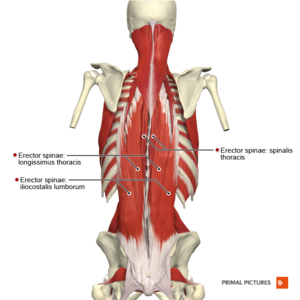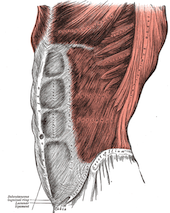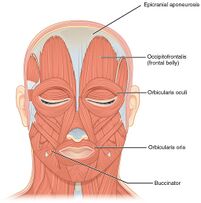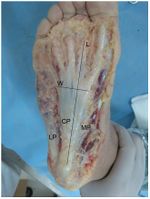Aponeurosis: Difference between revisions
No edit summary |
No edit summary |
||
| Line 19: | Line 19: | ||
== Aponeurosis of the External Oblique == | == Aponeurosis of the External Oblique == | ||
The aponeurosis of the external oblique is | [[File:Gray392 external abd obliques.png|right|frameless]] | ||
The aponeurosis of the external oblique is the broad, flat tendinous portion of the external abdominal oblique muscle. The fleshy fibers of the muscle end in the aponeurosis along a line descending vertically from the costochondral joint of the ninth rib then turning laterally just below the level of the umbilicus toward the anterior superior iliac spine. The fibers of the aponeurosis run medially and inferiorly, contributing to the anterior wall of the sheath of the rectus abdominis muscle and decussating with those of the contralateral aponeurosis at the median linea alba. Inferomedially, the aponeurosis is attached to the upper border of the pubic symphysis, the pubic crest, and pubic tubercle.<ref>The free dictionary [https://medical-dictionary.thefreedictionary.com/aponeurosis+of+external+oblique+(muscle) Aponeurosis of EO] Available: https://medical-dictionary.thefreedictionary.com/aponeurosis+of+external+oblique+(muscle)<nowiki/>(accessed 15.12.2021)</ref> | |||
The aponeurosis of the external oblique is formed of two layers: superficial and deep. The fibres of each layer are perpendicular to those of the other layer.<ref>Dommerholt J. Functional atlas of the human fascial system. Journal of Bodywork and Movement Therapies. 2015 Oct 1;19(4):679-80.Available:https://www.sciencedirect.com/topics/medicine-and-dentistry/aponeurosis (accessed 15.12.2021)</ref> | |||
== Epicranial Aponeurosis == | == Epicranial Aponeurosis == | ||
| Line 31: | Line 31: | ||
== Palmar Aponeurosis == | == Palmar Aponeurosis == | ||
The palmar aponeurosis of the hand is a continuation of the flexor retinaculum (the reinforcement of the distal part of the antebrachial fascia, also called transverse ligament of the carpus) and consists of transverse and longitudinal fibres | The palmar aponeurosis of the hand is a continuation of the flexor retinaculum (the reinforcement of the distal part of the antebrachial fascia, also called transverse ligament of the carpus) and consists of transverse and longitudinal fibres . The latter are part of the tendon sheaths of the flexor tendons (deep transverse metacarpal ligaments) and also connect to the capsules of the metacarpophalangeal joints. The aponeurosis is also connected to the deep fascia of the hand, which is attached to its skeleton. Together with the ligaments, septa and fasciae, the palmar aponeurosis forms a functional unit. During a strong grip it fixes the skin of the palm to the metacarpal bones and protects the soft tissues of the mid-hand<ref>Ombregt L. A [https://www.sciencedirect.com/topics/medicine-and-dentistry/aponeurosis system of orthopaedic medicine-E-Book]. Elsevier Health Sciences; 2013 Jul 25.Available: https://www.sciencedirect.com/topics/medicine-and-dentistry/aponeurosis<nowiki/>(accessed 14.12.2021)</ref> (see [[Palmar Aponeurosis]]) | ||
== Plantar Aponeurosis == | == Plantar Aponeurosis == | ||
The plantar aponeurosis (PA) originates from the calcaneal tubercle and extends to the forefoot. The aponeurosis consists of a medial, central and lateral part. | [[File:Plantar fascia 1.jpg|right|frameless|200x200px]] | ||
The plantar aponeurosis (PA) originates from the calcaneal tubercle and extends to the forefoot. The aponeurosis consists of a medial, central and lateral part. See [[Biomechanics of Plantar Fasciitis]]. One function of the PA is to support the foot arch<ref>Chen DW, Li B, Aubeeluck A, Yang YF, Huang YG, Zhou JQ, Yu GR. [https://www.ncbi.nlm.nih.gov/pmc/articles/PMC3879302/ Anatomy and biomechanical properties of the plantar aponeurosis: a cadaveric study]. Plos one. 2014 Jan 2;9(1):e84347.Available: https://www.ncbi.nlm.nih.gov/pmc/articles/PMC3879302/<nowiki/>(accessed 15.12.2021)</ref> | |||
One function of the PA is to support the foot arch<ref>Chen DW, Li B, Aubeeluck A, Yang YF, Huang YG, Zhou JQ, Yu GR. [https://www.ncbi.nlm.nih.gov/pmc/articles/PMC3879302/ Anatomy and biomechanical properties of the plantar aponeurosis: a cadaveric study]. Plos one. 2014 Jan 2;9(1):e84347.Available: https://www.ncbi.nlm.nih.gov/pmc/articles/PMC3879302/<nowiki/>(accessed 15.12.2021)</ref> | |||
== References == | == References == | ||
<references /> | <references /> | ||
Revision as of 05:52, 15 December 2021
Original Editor - User Name
Top Contributors - Lucinda hampton, Kim Jackson and Ahmed M Diab
Introduction[edit | edit source]
Aponeuroses are sheet-like elastic tendon structures that cover a portion of the muscle belly and act as insertion sites for muscle fibers while free tendons connect muscles to bones[1]. They have a role similar to a tendon but here is how they differ:
- An aponeurosis looks quite different than a tendon. An aponeurosis is made of layers of delicate, thin sheaths. Tendons, in contrast, are tough and rope-like. An aponeurosis is made primarily of bundles of collagen fibers distributed in regular parallel patterns, which makes an aponeurosis resilient.
- Aponeurosis has a function of absorbing energy during the movement of the muscle, while Tendon has a function of stretching and contracting during muscle movements.
- It is very rare for the Aponeurosis to get injured as it is situated hidden under many layers of bones and muscles. But Tendon gets injured easily, for it is present in all the injury-prone areas.
- Aponeuroses can act as fascia. Fascia is a fibrous tissue that envelopes muscles or organs, to bind muscles together or to other tissues.[2][3].
Erector Spinae Aponeurosis[edit | edit source]
The erector spinae aponeurosis (ESA) is a common aponeurosis that blends with the thoracolumbar fascia, with a proximal attachment on the sacrum an the spinous processes of the lumbar vertebrae, for the three erector spinae muscles (iliocostalis, longissimus, and spinalis) and overlying the inferior portion of the erector spinae muscles.[4]
The thoracolumbar fascia (TLF) and the erector spinae aponeurosis (ESA) play significant roles in the biomechanics of the spine. The ESA, at twice the thickness of the pTLF, is the thickest dense connective tissue (mean thickness: 1.85 mm) of the paraspinal compartment. [5]
Aponeurosis of the External Oblique[edit | edit source]
The aponeurosis of the external oblique is the broad, flat tendinous portion of the external abdominal oblique muscle. The fleshy fibers of the muscle end in the aponeurosis along a line descending vertically from the costochondral joint of the ninth rib then turning laterally just below the level of the umbilicus toward the anterior superior iliac spine. The fibers of the aponeurosis run medially and inferiorly, contributing to the anterior wall of the sheath of the rectus abdominis muscle and decussating with those of the contralateral aponeurosis at the median linea alba. Inferomedially, the aponeurosis is attached to the upper border of the pubic symphysis, the pubic crest, and pubic tubercle.[6]
The aponeurosis of the external oblique is formed of two layers: superficial and deep. The fibres of each layer are perpendicular to those of the other layer.[7]
Epicranial Aponeurosis[edit | edit source]
The epicranial (or galea) aponeurosis is a tough fibrous sheet of connective tissue that extends over the cranium, forming the middle (third) layer of the scalp. The epicranial aponeurosis also contains vessels that communicate between the deep vascular plexus contained within the subgaleal layer below as well as the superficial vascular plexus in the subcutaneous layer above[8].
Image : epicranial aponeurosis.
Palmar Aponeurosis[edit | edit source]
The palmar aponeurosis of the hand is a continuation of the flexor retinaculum (the reinforcement of the distal part of the antebrachial fascia, also called transverse ligament of the carpus) and consists of transverse and longitudinal fibres . The latter are part of the tendon sheaths of the flexor tendons (deep transverse metacarpal ligaments) and also connect to the capsules of the metacarpophalangeal joints. The aponeurosis is also connected to the deep fascia of the hand, which is attached to its skeleton. Together with the ligaments, septa and fasciae, the palmar aponeurosis forms a functional unit. During a strong grip it fixes the skin of the palm to the metacarpal bones and protects the soft tissues of the mid-hand[9] (see Palmar Aponeurosis)
Plantar Aponeurosis[edit | edit source]
The plantar aponeurosis (PA) originates from the calcaneal tubercle and extends to the forefoot. The aponeurosis consists of a medial, central and lateral part. See Biomechanics of Plantar Fasciitis. One function of the PA is to support the foot arch[10]
References[edit | edit source]
- ↑ Arellano CJ, Gidmark NJ, Konow N, Azizi E, Roberts TJ. Determinants of aponeurosis shape change during muscle contraction. Journal of biomechanics. 2016 Jun 14;49(9):1812-7. Available:https://pubmed.ncbi.nlm.nih.gov/27155748/ (accessed 15.12.2021)
- ↑ Study.com Aponeurosis Available: https://study.com/academy/lesson/aponeurosis-definition-function.html (accessed 15.12.2021)
- ↑ Ask any difference Aponeurosis and tendon Available:https://askanydifference.com/difference-between-aponeurosis-and-tendon/ (accessed 15.12.2021)
- ↑ IMAIOS Erector spinae aponeurosis - Aponeurosis musculis erectoris spinae Available:https://www.imaios.com/en/e-Anatomy/Anatomical-Parts/erector-spinae-aponeurosis (accessed 15.12.2021)
- ↑ Creze M, Soubeyrand M, Timoh KN, Gagey O. Organization of the fascia and aponeurosis in the lumbar paraspinal compartment. Surgical and Radiologic Anatomy. 2018 Nov;40(11):1231-42.Available: https://pubmed.ncbi.nlm.nih.gov/30171298/(accessed 15.12.2021)
- ↑ The free dictionary Aponeurosis of EO Available: https://medical-dictionary.thefreedictionary.com/aponeurosis+of+external+oblique+(muscle)(accessed 15.12.2021)
- ↑ Dommerholt J. Functional atlas of the human fascial system. Journal of Bodywork and Movement Therapies. 2015 Oct 1;19(4):679-80.Available:https://www.sciencedirect.com/topics/medicine-and-dentistry/aponeurosis (accessed 15.12.2021)
- ↑ Radiopedia galea Aponeurosis Available:https://radiopaedia.org/articles/galea-aponeurotica (accessed 15.12.2021)
- ↑ Ombregt L. A system of orthopaedic medicine-E-Book. Elsevier Health Sciences; 2013 Jul 25.Available: https://www.sciencedirect.com/topics/medicine-and-dentistry/aponeurosis(accessed 14.12.2021)
- ↑ Chen DW, Li B, Aubeeluck A, Yang YF, Huang YG, Zhou JQ, Yu GR. Anatomy and biomechanical properties of the plantar aponeurosis: a cadaveric study. Plos one. 2014 Jan 2;9(1):e84347.Available: https://www.ncbi.nlm.nih.gov/pmc/articles/PMC3879302/(accessed 15.12.2021)










